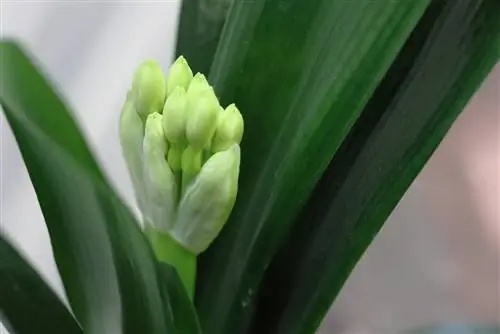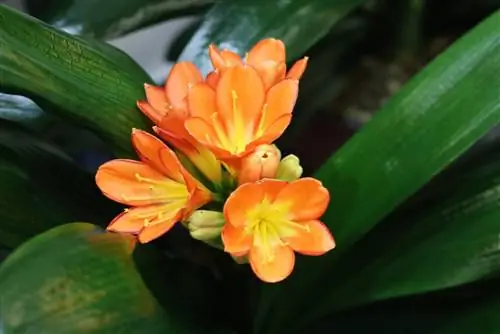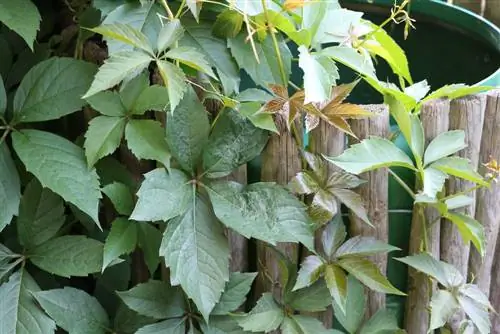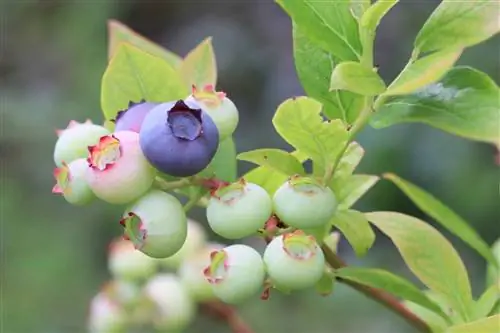- Author admin [email protected].
- Public 2023-12-17 03:39.
- Last modified 2025-01-24 12:45.
The older the houseplant, also known as belt leaf, gets, the more magnificent it is, provided the conditions are appropriate. It can reach heights of up to 50 cm. In late winter, the colorful flower stems, up to 60 cm long, appear in the middle of the leaves. The roots of the clivia are thick and fleshy, so it quickly fills the plant pot and needs to be repotted.
A timeless eye-catcher in orange
A few years ago the Klivia was almost a rarity because it was only found in a few households. Today, thanks to its appearance and relatively uncomplicated care, it is gaining more and more fans. The classic clivia has orange flowers. These are up to 13 cm large umbels, each with six to ten individual flowers. There are now also varieties with different colored flowers, each more beautiful than the other.
Their leaves, which can be even longer than the flower stems, form a beautiful contrast to the rich and intense flower colors. It begins to bloom when most other flowering plants are in hibernation and usually look rather desolate. Every now and then it needs to be repotted. However, there are a few things to consider.
The best time to repot
Like almost all houseplants, a clivia needs to be repotted from time to time. It is important to pay attention to the best possible time, the right planter and the most gentle approach.
- Thick, fleshy roots fill up the plant pot relatively quickly
- Despite everything, don’t repot immediately
- Neither too early nor too late and not too often
- Klivia likes it a little tighter in the pot
- The flower formation is even more lush
- As soon as the first roots emerge from the top of the pot, move them
- Repot into larger pot and fresh substrate
- Process means enormous stress for the plant
- Therefore choose a time during the flowering or dormant phase
- Should be done by early fall
- The plant then has enough time to grow and get used to it
As already mentioned, this plant blooms best when it is repotted as little as possible. However, at some point it can no longer be avoided. This is still possible every year for very young clivias, but things are different for older and recently repotted specimens. You only need to undergo this procedure every three to four years.
Remove from the old pot

First you take the clivia out of the old pot, which is sometimes not that easy. The fleshy roots should not be damaged or injured if possible.
- Grasp the clivia by the forelock and pull it out of the pot with a slight pull
- Be sure to avoid jerking out quickly
- Then remove loose soil from the bale
- To do this, gently tap a few times against a hard surface
- Remove stubborn lumps of earth under running water if necessary
- Check bales for rotten, dead or damaged parts and remove them
- Disinfect cutting tools before and after
What the new pot should be like
The clivia prefers it a little tighter in her pot. Therefore, the new one should ideally not be more than two centimeters taller than the old one. Since this plant tends to grow wide and tip over, it is advisable to use heavy planters. This way you can give it some stability. It's good if the plant pot itself is a bit heavier. It should also have drainage holes to prevent the formation of waterlogging. Appropriate drainage made of coarse gravel or pottery shards on the bottom of the pot can also be helpful in this regard.
Suitable substrate
It is best to only use high-quality substrate mixtures for Clivia. This can be a commercially available, peat-free potting soil or potting soil that is mixed with clay granules, pumice gravel or cactus soil in a ratio of 2:1 or 3:1, or good garden soil mixed with sand. A loose, permeable, sandy-loamy, humus-rich and nutrient-rich as well as fresh to moderately moist soil with a slightly acidic to acidic pH value is recommended. The substrate should not be too calcareous, although the clivia has a certain lime tolerance.
Potting Clivia
Once you've found the right planter, it's time to pot it up. To do this, first fill a drainage layer about two centimeters thick into the pot. Then you fill in some of the substrate and insert the clivia in the middle. Now fill with soil up to approx. two centimeters below the edge of the pot. To avoid cavities between the roots, gently shake the plant while filling. This allows the earth to settle and cavities are filled. Finally, press the substrate firmly and pour the whole thing. Freshly potted plants are fertilized for the first time after three to four weeks at the earliest.
Tip:
You may need to add some substrate after a day or two if it has still settled.
The best location after repotting
After repotting, pay attention to the right location, this also contributes to flower formation.
- Should be bright, without direct sunlight
- Window seat facing east or west is ideal
- Partial shade is tolerated, but flower production is then reduced
- From mid-May in a sheltered, draft-free, bright place outdoors
- In autumn, when temperatures start at five degrees, go back indoors
- Klivia doesn't like moving around as much as she doesn't like frequent pot rotation
- From October to February, ambient temperatures between ten and twelve degrees

When the flower buds form, the temperature is increased to around 15 degrees. If it is warmer, it usually shortens the flowering period, because the clivia prefers it a little cooler. Even in summer it shouldn't be warmer than 20-22 degrees.
Tip:
If it is possible to keep the belt leaf cooler in the summer, with a bit of luck it will already be blooming at Christmas.
Propagation
The propagation of clivia can be done by various methods.
Through seeds
One way to propagate a pretty clivia is through seeds or sowing. However, this method requires a lot of patience, because it can take around five years for specimens propagated from seeds to produce flowers for the first time. The seeds for this can be purchased commercially or, with a bit of luck, obtained from existing plants or their flowers.
Winning seeds
In order to be able to harvest suitable seeds for sowing, you first have to wait after flowering and let the seeds ripen on the plant. This assumes that the clivia flowers, which it will only do for the first time after three years at the earliest, provided the conditions are right. Once the flowers have withered, small fruits ripen on the flower stalks, in which the seeds develop. They are ripe when they begin to germinate, which in the case of clivies occurs directly on the plant. Then they are usually dark red and easy to remove. As long as the seeds are immature, they will not germinate.
Sowing seeds
For sowing you need small pots that you fill with a commercially available potting soil. It is also possible to sow in a seed tray. However, small pots have the advantage that they only have to be repotted after a few months, which the Clivie doesn't like anyway.
- Press the seeds carefully into the moistened substrate
- If possible, no more than two seeds per pot
- From now on, always keep the soil evenly moist
- Earth must not dry out completely
- Put translucent foil over pots for optimal germination conditions
- Then place in a warm, bright place without direct sunlight
- Air the film briefly once a day to avoid rot and mold formation

After a few weeks the first seedlings have developed. If sown in seed trays, the young plants from a size of around 15 cm can be planted in their own pots and further cultivated accordingly. If this method is too tedious for you, you can also propagate the belt leaf using Kindel, which is much quicker and more effective.
About side rung
Vegetative propagation via side shoots or kindles is the easiest way to get new plants. Before you separate them from the mother plant, they should have reached a minimum size of 20 cm. In addition, they should have enough roots to be able to grow at all.
- Best time, right after flowering
- Carefully cut off the child at the point of attachment
- Only use sharp and previously disinfected knives
- Place the interface briefly in charcoal powder
- Then place in small pots with high-quality substrate
- Preferably use a peat-sand mixture as a substrate
- Keep evenly moist again until germination
For optimal germination conditions, higher humidity can be helpful, which can be achieved with a cover made of translucent film. As soon as the first fresh leaves form, rooting has been successful, the film can be removed and the young plants can continue to be cultivated as normal. It takes about two to three years for the newly grown plants to bloom for the first time.
Tip:
For propagation via Kindel, you should avoid separating all Kindel from the mother plant. If you leave a few on the plant, it will grow much more luxuriantly and therefore produce more inflorescences.
Division

Dividing the Clivie is not recommended but is still possible. If you separate the root ball of a clivia, it can work well or the plant will die. The best time to do this is during regular repotting. Take the plant carefully out of the pot and remove the loose soil from the ball. Then shorten the roots by about a third and cut them in the middle. The sections are then immediately placed in sufficiently large pots with high-quality substrate and watered.
Toxicity
The strap leaf (Clivia miniata) is one of the poisonous houseplants. It is slightly poisonous in all parts of the plant. This is due to the alkaloid lycorine, which is contained in the plant. If individual parts of the plant get into the mouth or are swallowed, small children and sensitive people can experience side effects such as nausea, vomiting, headaches, diarrhea, increased salivation and also kidney damage.
Therefore, the Klivia should be placed where possible so that neither small children nor pets can reach it, because this plant is also poisonous for dogs and cats. If symptoms of poisoning occur, especially in small children and pets, you should consult a doctor or veterinarian. In addition, it is advisable to always wear gloves when handling the Clivia.






